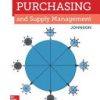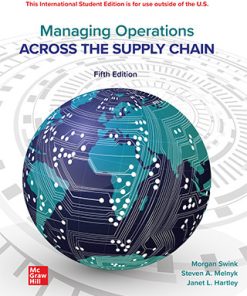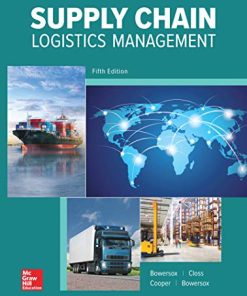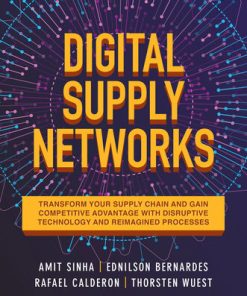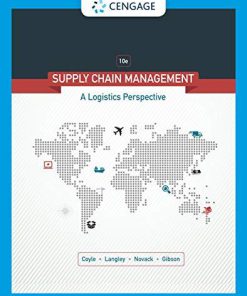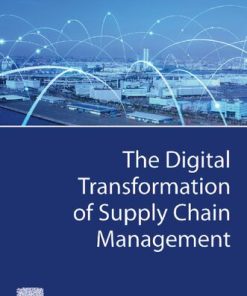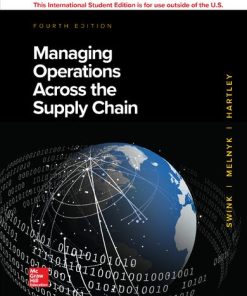The Digital Supply Chain Bart L. Maccarthy
$50.00 Original price was: $50.00.$25.00Current price is: $25.00.
The Digital Supply Chain – Ebook Instant Download/Delivery ISBN(s): 9780323916141,0323916147
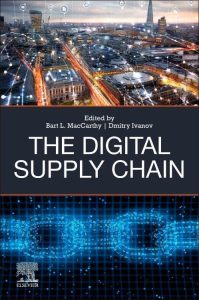
Product details:
- ISBN-10 : 0323916147
- ISBN-13 : 978-0323916141
-
Author(s): Bart L. MacCarthy, Dmitry Ivanov
The Digital Supply Chain is a thorough investigation of the underpinning technologies, systems, platforms and models that enable the design, management, and control of digitally connected supply chains. The book examines the origin, emergence and building blocks of the Digital Supply Chain, showing how and where the virtual and physical supply chain worlds interact. It reviews the enabling technologies that underpin digitally controlled supply chains and examines how the discipline of supply chain management is affected by enhanced digital connectivity, discussing purchasing and procurement, supply chain traceability, performance management, and supply chain cyber security. The book provides a rich set of cases on current digital practices and challenges across a range of industrial and business sectors including the retail, textiles and clothing, the automotive industry, food, shipping and international logistics, and SMEs. It concludes with research frontiers, discussing network science for supply chain analysis, challenges in Blockchain applications and in digital supply chain surveillance, as well as the need to re-conceptualize supply chain strategies for digitally transformed supply chains.
Table contents:
Part I. Introduction
Chapter 1. The Digital Supply Chain—emergence, concepts, definitions, and technologies
1. A transformative decade
2. Emergence of the Digital Supply Chain
3. Building blocks for the Digital Supply Chain
4. Defining the Digital Supply Chain
5. Many opportunities, many challenges
6. Outline of book contents
Part II. Digital building blocks and enabling technologies
Chapter 2. Digital Manufacturing: the evolution of traditional manufacturing toward an automated and interoperable Smart Manufacturing Ecosystem
1. Introduction—the evolution of production paradigms
2. Interoperability and automation
3. Interoperable Digital Twins and predictive maintenance in modern manufacturing
4. Digitalization and smart factories: trends and future challenges
5. Conclusions
Glossary of acronyms
Chapter 3. Smart warehouses—a sociotechnical perspective
1. The digital supply chain transforms the requirements for warehousing
2. Warehouse management
3. Smart warehouses: enabling technologies
4. Order-picking in the smart warehouse
5. Smart warehouses are sociotechnical systems
6. Conclusions
Chapter 4. The Internet of Things—an emerging paradigm to support the digitalization of future supply chains
1. Introduction
2. The basic concepts of IoT
3. Supply chain management, novel digital technologies, and IoT
4. IoT applications in OM and SCM
5. Future challenges for IoT in the supply chain
6. Perspectives on IoT adoption and implementation in supply chains
7. Conclusions, limitations, and future research
Appendix A
Chapter 5. The cloud, platforms, and digital twins—Enablers of the digital supply chain
1. Introduction
2. Perspectives on cloud-based systems
3. Platform technologies
4. Digital twins
5. Conclusions
Chapter 6. Algorithms, Analytics, and Artificial Intelligence: harnessing data to make supply chain decisions
1. Introduction
2. Current and prevalent algorithms and AI techniques
3. Current AI and algorithmic applications with the most impact
4. Potential techniques and emerging areas of application for AI and algorithms
5. Conclusion and perspectives
Chapter 7. The impact of digitalization on contemporary and future logistics
1. Introduction
2. Digitalization in logistics and supply chain management
3. Cloud-based systems
4. Emerging technologies
5. Concluding observations and future prospects
Chapter 8. Blockchain technologies in the digital supply chain
1. Introduction
2. Functionality of blockchain
3. Blockchain in the academic supply chain literature
4. Industrial applications of blockchain
5. Conclusion and further research
Part III. Managing the Digital Supply Chain
Chapter 9. Digital architectures: frameworks for supply chain data and information governance
1. Introduction
2. Data as a resource—the need for data quality
3. Data and information architectures
4. Data sharing agreements
5. Data attributes, sharing, and access control
6. Actors, roles, and relationships in data sharing
7. Conclusions
Chapter 10. Supply chain traceability systems—robust approaches for the digital age
1. Introduction
2. Visibility, transparency, and traceability
3. Motivations for traceability and transparency
4. Information requirements for traceability systems
5. Enabling technologies
6. Challenges
7. An illustrative case: the wood supply chain
8. Conclusion
Chapter 11. Digital purchasing and procurement systems: evolution and current state
1. Introduction—the rise of digital procurement systems
2. The development of digital procurement systems
3. Research perspectives on digitalization of procurement
4. Hitachi case study
5. Looking ahead: the future of digital procurement systems
6. Conclusions
Chapter 12. Measuring and managing digital supply chain performance
1. Introduction
2. A framework for performance management in digital supply chains
3. Case studies
4. Impact of emerging technologies on performance measurement and management
5. Conclusions
Chapter 13. The art of cyber security in the age of the digital supply chain: detecting and defending against vulnerabilities in your supply chain
1. Introduction
2. Governments, consultancies, and industry approaches
3. Research on supply chain cyber security
4. Research frontiers
5. Conclusions
Part IV. Digital Supply Chain — sectoral cases
Chapter 14. Digital retail—key trends and developments
1. Introduction
2. The reshaping of the retail value chain
3. Platform-based retail ecosystems—the cases of Alibaba and Amazon
4. Discussion
5. Conclusions
Chapter 15. Digitalization in the textiles and clothing sector
1. Introduction
2. Digital clothing design and sample development
3. Digitalization of clothing supply and manufacturing networks
4. Digitalization of clothing distribution and retail formats
5. Digitally enabled clothing circularity
6. Conclusions
Chapter 16. Digitalization in production and warehousing in food supply chains
1. Introduction
2. DigiMat—an innovation project between a food supply chain and academia
3. Characteristics of food supply chains
4. Introduction to cases
5. Conclusions and future research perspective
People also search:
the digital supply chain
the digital supply chain company
the digital supply chain podcast
warehouzez- the digital supply chain
ax4 the digital supply chain
the digital supply chain pdf
the digital supply chain—emergence concepts definitions and technologies
You may also like…
Business & Economics - Management & Leadership
Business & Economics
Supply Chain Logistics Management 5th Edition Donald 0077729137 9780077729134
Business & Economics - Management & Leadership
Business & Economics - Logistics
Uncategorized
Business & Economics - Logistics
The Digital Transformation of Supply Chain Management 1st Edition Michela Pellicelli
Business & Economics - Management & Leadership




